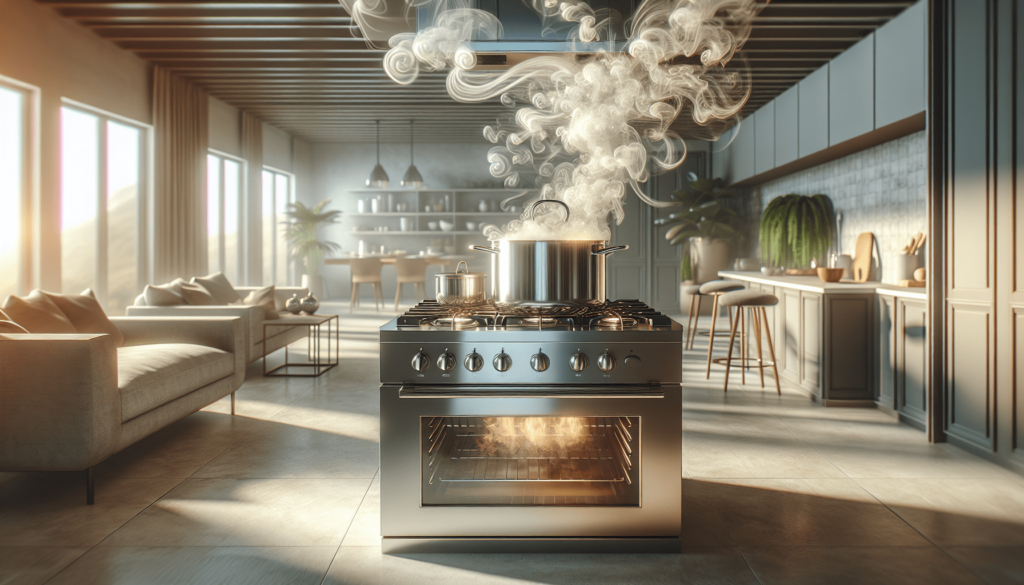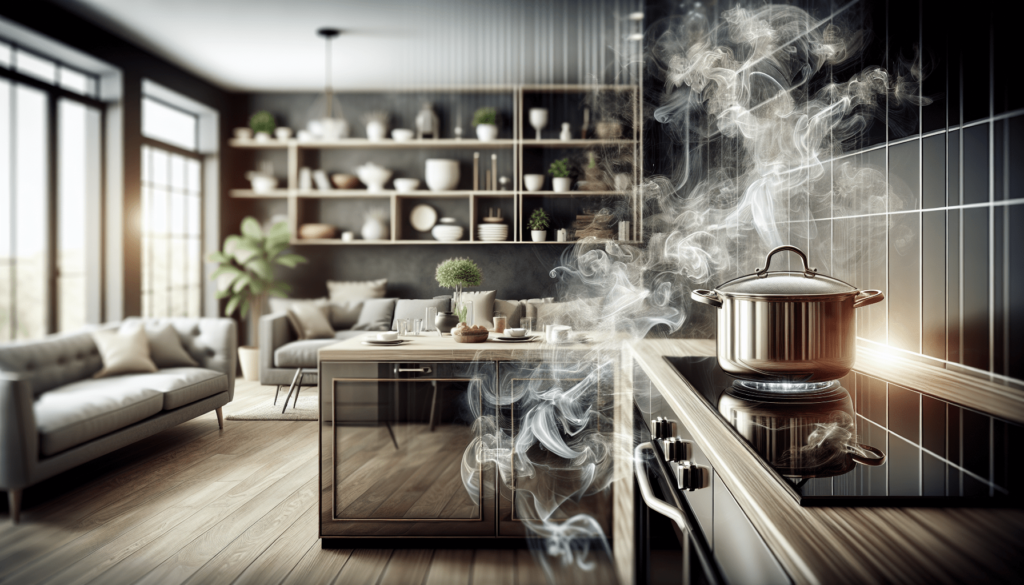Have you ever noticed that sometimes, after whipping up a delicious meal in your kitchen, someone in your household starts sneezing, coughing, or experiencing itchy eyes? It’s easy to overlook, but cooking odors might be the culprit behind these allergic reactions. Let’s uncover how cooking odors can trigger allergies in the living area and understand the possible link between the two.
Understanding Cooking Odors
Cooking odors are more than just the pleasant or unpleasant smells that waft through your home when you cook. They consist of complex combinations of particles, gases, and volatile organic compounds (VOCs). These elements can linger in your living area long after the meal is over, potentially triggering allergic reactions.
Sources of Cooking Odors
There are several common sources of cooking odors, including:
- Spices and Herbs: Certain spices like pepper, turmeric, and garlic release potent aromatic compounds.
- Cooking oil and fats: These can produce fumes, especially when heated to high temperatures.
- Smoke from charring: Grilling or frying food can create smoke that spreads through the house.
- Food itself: Certain foods, like fish or onions, have strong smells that can permeate the living area.
Components of Cooking Odors
Cooking odors often consist of a mix of particles and gases. Some of the components include:
- Particulate Matter (PM): Tiny particles that can become airborne and inhaled.
- Volatile Organic Compounds (VOCs): Organic chemicals that easily become vapors or gases.
- Polycyclic Aromatic Hydrocarbons (PAHs): Compounds formed during the incomplete combustion of organic matter.
- Aldehydes and Ketones: By-products of cooking certain foods.
Allergies and Their Symptoms
Allergies are caused by your immune system reacting to a foreign substance. Common allergens include pollen, pet dander, dust mites, and certain foods. But did you know that components of cooking odors can also act as allergens?
Common Symptoms of Allergies
When your body detects an allergen, it releases chemicals like histamines. This can lead to a range of symptoms, such as:
- Respiratory Issues: Sneezing, coughing, congestion, and shortness of breath.
- Skin Reactions: Itching, hives, and eczema.
- Eye Irritation: Redness, itching, and watering of the eyes.

How Cooking Odors Can Trigger Allergies
Certain cooking activities can release allergens into the air. These allergens can then make their way into your living area, causing allergic reactions. The process involves several steps:
Release of Allergens
When cooking, especially high-temperature methods like frying or grilling, various allergens can be released. For example:
- Proteins: Cooking fish or shellfish can aerosolize proteins that are common allergens.
- Spices: Grinding or heating certain spices can release microscopic particles that can be inhaled.
Dispersal of Allergens
Once released, these allergens can quickly spread through your living space. Factors that aid their dispersal include:
- Ventilation Systems: Poorly maintained HVAC systems can distribute allergens throughout your home.
- Air Flow: Open windows and fans can carry allergens from the kitchen to other areas.
Inhalation and Exposure
As you breathe in these airborne particles, your immune system may react if you’re sensitive or allergic. This leads to the symptoms mentioned earlier, making your living area uncomfortable.
Common Cooking Odors That Trigger Allergies
Not all cooking odors are created equal. Some are more likely to cause allergic reactions than others. Below is a table summarizing common cooking odors and their potential to trigger allergies.
| Cooking Odor Source | Potential Allergens | Possible Reactions |
|---|---|---|
| Fried Foods | Particles, smoke, VOCs | Respiratory issues, skin irritation |
| Spices | Microscopic particulate matter | Sneezing, eye irritation |
| Fish and Shellfish | Aerosolized proteins | Asthma attacks, respiratory distress |
| Moldy Foods (e.g., old bread) | Mold spores | Nasal congestion, coughing |

Preventive Measures
Understanding how to prevent or minimize the spread of cooking odors and allergens can help you create a healthier living environment.
Proper Ventilation
Adequate ventilation is crucial in reducing the impact of cooking odors on indoor air quality.
- Use Range Hoods: Make sure your kitchen is equipped with a functional range hood that vents outside.
- Open Windows: Allow fresh air to circulate to dilute indoor pollution.
- Portable Air Purifiers: Consider using HEPA-filtered air purifiers to trap airborne particles.
Cleaning and Maintenance
Keeping your kitchen and living area clean is another effective strategy.
- Regular Cleaning: Clean cookware and surfaces immediately after cooking.
- Maintain HVAC Systems: Change filters regularly and have your system inspected.
- Use Non-Toxic Cleaners: Reduce chemical load by using natural or non-toxic cleaning solutions.
Cook with Caution
When preparing food that is known to produce strong odors, take extra steps to limit exposure.
- Cook Outdoors: If feasible, grill or use a portable burner outdoors.
- Isolate Cooking Area: Close off the kitchen from other rooms, if possible, while cooking.
Allergy Control Practices
Adopting specific allergy control measures can also make a significant difference.
- Allergen-Proof Bedding: Reduce allergens in the sleeping area.
- Frequent Laundry: Wash curtains, upholstery, and other soft furnishings regularly.
- Frequent Vacuuming: Use a vacuum cleaner with a HEPA filter to capture allergens.
Understanding Air Quality in Your Living Area
Knowing the quality of air in your home can help you take targeted actions to improve it.
Air Quality Monitors
Air quality monitors can measure levels of particulate matter, VOCs, and other pollutants. Investing in one can offer valuable insights.
Common Indoor Pollutants
Besides cooking odors, several other pollutants can impact your indoor air quality:
| Pollutant Type | Sources |
|---|---|
| Dust and Dust Mites | Household dust, soft furnishings |
| Pet Dander | Pets |
| Mold and Mildew | Damp areas like bathrooms and basements |
| Chemical Pollutants | Cleaning products, paints, and solvents |
Reducing Overall Indoor Pollution
Adopting a holistic approach to reduce indoor pollution can complement your efforts against cooking odors.
- Maintain Humidity Levels: Use dehumidifiers to keep indoor humidity between 30-50%.
- Houseplants: Some plants can help filter indoor air.
- Avoid Smoking Indoors: This can significantly worsen indoor air quality.
Health Impacts of Prolonged Exposure
Understanding the long-term effects of exposure to cooking odors and allergens can be eye-opening.
Respiratory Issues
Chronic exposure to allergens can lead to ongoing respiratory problems, including:
- Asthma: Worsened symptoms and increased asthma attacks.
- Chronic Bronchitis: Persistent cough and mucus production.
- Sinusitis: Inflammation and infection of the sinuses.
Skin and Eye Irritation
Prolonged exposure can also affect your skin and eyes.
- Dermatitis: Chronic skin inflammation, rashes, and itching.
- Conjunctivitis: Red, itchy, and watery eyes.
Mental Health
Poor indoor air quality can even affect your mental well-being.
- Anxiety and Stress: Constant physical discomfort can lead to increased stress levels.
- Sleep Disturbances: Allergic symptoms can disrupt sleep, contributing to fatigue and irritability.
Consulting a Professional
Sometimes, despite your best efforts, allergies persist. Consulting a healthcare provider can offer additional insights and solutions.
Allergy Testing
Identifying specific allergens responsible for your symptoms allows for targeted interventions. Allergy tests can be conducted through:
- Skin Prick Test: Small amounts of potential allergens are applied to your skin.
- Blood Test: Measures the level of allergens-specific antibodies in your blood.
Medical Treatments
Your healthcare provider may recommend treatments such as:
- Antihistamines: To counteract histamine release and alleviate symptoms.
- Steroids: For more severe allergic reactions.
- Immunotherapy: Gradual exposure to allergens to build immunity.
Professional Cleaning Services
Hiring professionals to deep clean your home can also help remove hidden allergens and improve air quality.
Conclusion
Cooking can indeed fill your home with wonderful aromas, but it’s important to be aware of the potential allergens that come with it. By understanding the link between cooking odors and living area allergies, you can take the necessary steps to create a healthier home environment. With effective preventative measures and proper home maintenance, you can continue enjoying your culinary adventures without compromising on your family’s well-being.
